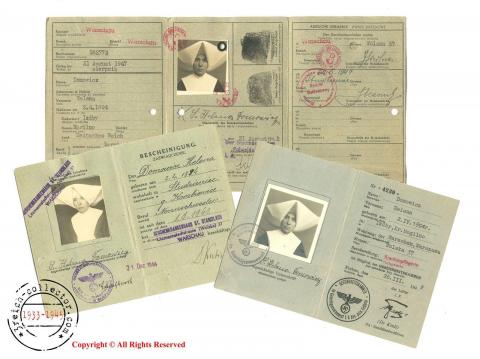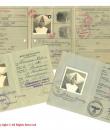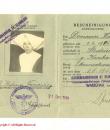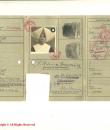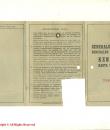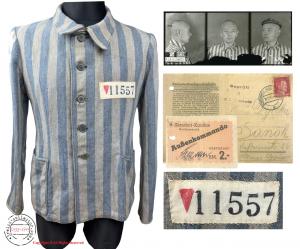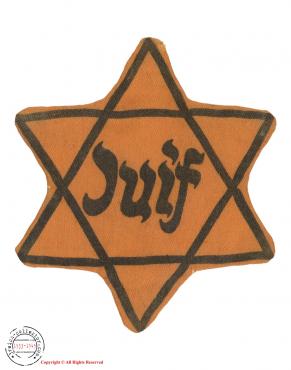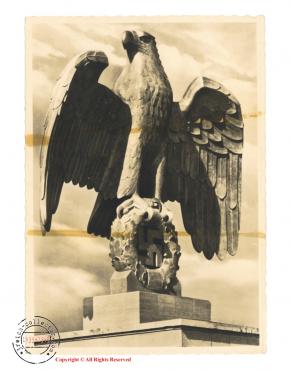Very interesting set of 3 identity cards issued to a Polish sister that worked as nurse in the famous hospital of St. Stanislau, that was directly connected to the Warsaw Uprising and Ghetto Uprising.
| Price: | $680.00 |
Very interesting set of 3 identity cards issued to a Polish sister that worked as nurse in the famous hospital of St. Stanislau, that was directly connected to the Warsaw Uprising and Ghetto Uprising.
Documents included, all in good condition are:
1. Generalgouvernement / Generalne Gubernatorstwo / Kennkarte / Karta Rozpoznawcza, Kennumer / Identification number 182773, Kennort / Place of exhibition Warschau (Warsaw). With photo of the noon and with the Nazi stamp cut out.
2. Ausweis (identity card), issued by: Gesundheitskammer im Generalgouvernement Krakau (Chamber of Health, General Governorate of Krakow) regarding the position in the profession: Krankenpflegerin / Nurse. With photo of the noon.
3. Ausweis (identity card), issued on 21 Dez. (October) 1944, for barmh. - Schwester (sister of mercy) Domowicz Helena, Beruf (profession): Nonnschwester (sister) - Seuchenkrankenhaus St. Stanislaus Litzmannstadtstrasse (Wolska) 37 Warschau (Infectious Hospital St. Stanislaus in Warsaw Łódzka Street (formerly Wolska Street) 37 Warsaw). With photo of the noon.
Important references about the hospital during the war:
In 1939 there were 600 beds in the hospital, and the director was Roman Ignacy Szpikowski. In the first days of the siege of Warsaw, the Reception Room building was demolished, in the rubble of which the doctor on duty Dr Janina Dalikowska and the nurse nun Sister Wójcik died. The director of the hospital, Dr. Szpikowski and assistant doctor Józef Pakulska, were covered with rubble. After the end of hostilities, all the personnel merged in all forms of the underground struggle with the invader, and the special tasks included: contacts with the Ghetto resistance movement, rescuing Pawiak prisoners condemned to death and protection of the civilian population. The nature of the hospital was used, its location in the vicinity of cemeteries and vegetable gardens. The group of organizers of the movement: doctor Szpikowski - hospital director and employees of Henryk Iwański, Paweł Kowalski, Stanisław Sokolnicki, Jan Skoczek, Zdzisław Nosarzewski, Marian Kowalski, joined all doctors, hospital chaplain, priest. Władysław Smyrski, nurses with head nurse, Helena Berne, and manual workers: Pludowski, Piekarzewski, Iwański, Senderski, Kruszewski, Kania, Motyliński, Dyjakowski, Paradowski, Jurczyński, Jagodziński, Mikołajko, Deliskek, Piskorowski, Bawarski, Ogrodowski, Mikulski, Wysocka , Bujakowska, Lichota, Filipiński, Gregorkiewicz, Zacharski, Lewandowski. The commander of the group was Capt. Henryk Iwański, and deputies Paweł Kowalski and Jan Skoczek. The Infectious Disease Group issued various types of false certificates, kept people at risk and Jews, purchased, stored and distributed ammunition and weapons, produced pomegranates, filipinki( type of grenade), radio listened and distributed newsletters, conducted combat training and thrown threatened to the east. the most important actions included:
• Digging hidden by the Polish Army in the St. Lazarus defends and transports her in trolleys to rubbish to the premises of the Infectious Hospital
• Transporting weapons from the Infectious Hospital (in the carpet) to the apartment of the director of Dr. Szpikowski
• Transport of weapons in oxygen tanks to the Grójecka railway station
• Transport of weapons to the Ghetto in cooperation with a group of Jews under the command of Dr. Celmajster - Niemirski
• Transfer and concealment of weapons and explosives after the arrest of Jan Skoczek, a member of the hospital group
• Contact with representatives of the Jewish hospital, director Goldfarb, doctor Celmajstra-Niemirski and doctor Tomerson, after a conference held in the apartment of director Szpikowski
• Delivery to the Ghetto before and during the uprising of food, medicines, weapons, ammunition, transfer of Jews and two Soviet parachutists Kostaniew and Fedor from the Ghetto through the church in Leszno with the help of the parish priest, priest. Godlewski
• Leaving the Ghetto, after the fall of the uprising, a thirty-strong fighting group with full weaponry and hiding it in the hospital, and then to the east
• Making and issuing false certificates and work documents
• Collecting and transferring infected material to prisoners to the Pawiak to enable them to get to the Infectious Hospital
• Issuing a certain corpse to German authorities instead of a Weinclowa prisoner sentenced to death, and sent from the Pawiak, by implanting her infectious disease
• Enabling the escape from the "care" of the navy police of 4 Pawiak prisoners staying on observation in the hospital
• Participation in the Warsaw Uprising in the Chrobry Group.
During the occupation, a lab technician Józef Ogrodowski died in the execution of the street, and one of the most active from the hospital group host Jan Skoczek, arrested in Grójec, was shot by the Gestapo.
Dr Tadeusz Mockałło, involved in the transmission of contaminated material to the Pawiak prison and taking over infected prisoners, arrested and later released, after re-summoning the Gestapo, took refuge in the eastern territories.
The Warsaw Uprising surprised director Szpikowski in the house at ul. Biała, from where he tried to get to the Infectious Disease Hospital. On the way he stopped at the Hospital of John of God, from where he left after the artillery fire, which completely destroyed the hospital. Having closed the road to Wola, he took over the dressing point of the "Parasol" and "Zoska" battalions, located at ul. Długa 23, where he died in the first days of September from a German cannonball.
The outbreak of the Warsaw Uprising immediately mobilizes the Infectious Hospital to sanitary services on the section of Wola. The business manager Włodzimierz Włodarski sets sanitary points and notifies doctors. They report immediately: Dr. Józef Pakulska, Dr. Stanisław Kulesza, Dr. Mieczysław Rogalski, Paweł Kubica, late in the evening, and Dr. Jan Barcz at night.
On August 3, close to the shots are lost: the manager of the pharmacy, M. Dzdziak, and six men who try to take shelter in the hospital.
On August 5, the hospital is undergoing the horror of mass executions. After burning the Franaszek factory adjacent to the hospital and murdering the owner's crew and family, the gangs of soldiers were shooting at the hospital gate. Porter Władysław Przesmycki, after opening the gate, dies from a close shot, and immediately after the hospital workers die: Stefan Mikulski, Kazimierz Tyczyński, Aleksander Delążek and Władysław Kwiatkowski. Expelled and grouped at the exit gate, the hospital staff, patients and fugitives from neighboring homes await the announced execution. After the first volleys, the brave and energetic intervention of doctor Paweł Kubica interrupts the action and leads to negotiations, as a result of which the German doctor Hartlib, the head of the health care section, interrupts the execution. On that day, 10 people from outside the hospital lost their lives and Dr. Jan Barcz and a field worker Marek Iliński, and priest Niczyporowicz was seriously injured.Dr Kubica, whose attitude rescued those remaining from death, moved to the position of the hospital's representative, shielding the staff, sick and hiding from the Germans attacks and protecting hospital property against plunder. In the evening of that fateful day, the infectious hospital doctor Dr. med. Manteuffel, doctor Dr. Wesołowski and med. Wardzianka were brought in to strengthen the cast of the German operating point, created in the Infectious Hospital. They brought a message about the monstrous murder of all doctors at the Wolski Hospital.
On August 6, an operational and dressing point for Gen. Reinefart's group was created, and Dr. Hartlib and General Dirlewanger lived in the hospital, under whose terror the hospital remained until evacuation.
During the following days, the Hospital doctors were helping the wounded in the basements of burned-out houses and supplying the drugs and food to the people evacuated from Warsaw. It was particularly dangerous to provide food for the employees of the Franaszek factory at night, survivors of mass executions and hiding in the sewers of the factory. These employees were then taken to the hospital and placed in the patients' rooms.
On August 13, the Gestapo unit ordered an appeal by all doctors to take them to the camp in Pruszków. Another intervention of Dr. Kubica at Hartlib releases the doctors and other staff of the Hospital, enabling them to continue to care for the sick and the hiding. In these interventions Kubica, a medical student, is valiant, seconded to Joanna Kryńska, whose personal courage and good command of German have in many cases facilitated contact with the German authorities and understanding the hospital's needs. However, it was not possible to prevent another round-up of physical personnel and people in hiding, who were transported to Pruszków and Suchedniów in lots.On the day of the outbreak of the Uprising, the hospital - after the marching out of battle groups - became a place of refuge for about 600 inhabitants, some of whom the hospital staff transported outside of Warsaw in numerous expeditions for food and supplies. The hospital also organized help points for the evacuated population, releasing hot coffee and food. These points, after a few days of activity, were destroyed by the Germans after a previous photographing.
On 9 August, the Germans brought two juvenile insurgents to the hospital area and, after destroying their clothes and photographing them with the Polish flag, they hung on the tree.
At the end of October, the hospital unexpectedly received an evacuation order to the suburban area, and an extremely short deadline was given to prevent the removal of all valuable equipment. The dynamic organization and participation of all personnel in transport made it possible to send seriously ill patients to Kraków, children to Milanowek, and the remaining 60 patients, workers and equipment, underwear and food - to Radziwiłł Mazowiecki. The assets of the Hospital, discharged on the bedside, had to be guarded day and night until they were transported to Studzieniec, where the Hospital was located in abandoned buildings of the Juvenile Education Center.Only a three-man safety team remained in the hospital.
In the emptied spaces Infectious Diseases Hospital Germans great magazines of ammunition and explosives, which caused a partial explosion completely destroyed the four-storey pavilions, collapse to half the three-story pavilion ,, scarlet fever "and serious damage to the observation pavilion. Destruction fulfilled before leaving Germany, dismantling any equipment Mechanical kitchen, laundry room, boiler room and branches, also taking other equipment and underwear.
In the period from 1939 to 1944, in addition to the above, they died outside the hospital:
Gardener Kazimierz Podolsky, head of the office Sokolniki Stanislaw, Stanislaw Filipino accountant, cashier Denis Kornowski, clerk Hanna Dadajewska and disappeared without trace Zdzislaw Nosarzewski economic manager.
After the fall of the Warsaw Uprising, Jerzy Wilczyński, the guardian of the combat group at ul. Zamienieckiej 73. Dr Witold Gadomski, dr Jan Ryfinski and Eng. Kafliński, for the sake of young people grouped there, used the fear of the occupier against infectious diseases and obtained approval for the commander of the unit Wuilburga hospital infectious Street. Siennicka 15, in which staff and patients ,, "former insurgents and threatened expulsion of the population of Prague. On 14 August 1944, was created on Prague street. Siennicka 15 Hospital of Infectious Diseases, whose directors were: Dr. Jan Ryfiński later Jerzy Wilczynski and from October 1, 1944, Dr. Alfons Krysztof.
